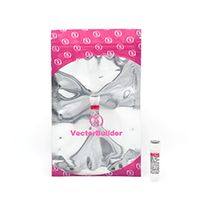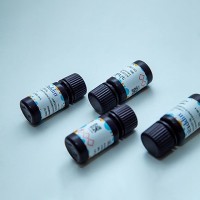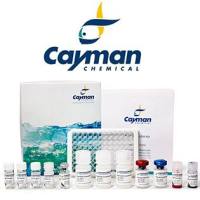【求助】可以利用RNA干扰针对某一基因的启动子进行沉默吗?
丁香园论坛
1462
请教:
能否利用RNA干扰沉默某一基因(如P53)的启动子进行沉默?这一想法可行吗?
急盼回复!非常感谢!
能否利用RNA干扰沉默某一基因(如P53)的启动子进行沉默?这一想法可行吗?
急盼回复!非常感谢!
Why not?
See review below.
The gene-silencing process of RNA interference (RNAi) involves the manufacture of short, double-stranded RNA molecules by an enzyme called DICER, which cleaves RNA duplexes into 21–26 base-pair oligomers. These small interfering RNAs (siRNA) cause sequence-specific post-transcriptional gene silencing by guiding an endonuclease, the RNAi-induced silencing complex (RISC), to mRNA. This process has been seen in a wide range of organisms such as Neurospora fungus (quelling), plants (post-transcriptional gene silencing), and mammalian cells (RNAi). Recent reports1 and 2 KV Morris, SW-L Chan, SE Jacobson and DJ Looney, Small-interfering RNAinduced transcriptional gene silencing in human cells, Science 305 (2004), pp. 1289–1292. Full Text via CrossRef | View Record in Scopus | Cited By in Scopus (315)2 have now extended the repertoire of RNAi events in human cells by describing siRNAinduced transcriptional silencing through promoter methylation.
Regional methylation is associated with gene silencing; demethylation is associated with gene activation. By inactivation of promoter hypermethylation of tumour-suppressor genes, tumour cells can prevent expression of proteins that suppress growth. Inhibitors of DNA methyltransferase have attracted much interest from researchers because of the potential to restore growth control in human tumours with aberrant promoter methylation.3 For example, clinical trials have shown that 5-aza-2′-deoxycytidine, a nucleoside inhibitor of DNA methyltransferase, has antitumour activity in myeloid malignant disorders.4 However, there are concerns that epigenetic treatments might promote non-specific gene activation and damage healthy cells.
Conversely, promoter hypomethylation could activate genes that increase invasiveness or metastatic potential. For example, treatment of the invasive breast-cancer cell line MDA-231 with S-adenosylmethionine (AdoMet; which leads to hypermethylation) inhibits expression of urokinase-type plasminogen activator and cell invasion; expression and invasiveness is restored by the demethylating agent 5′-azacytidine.5 and 6
Short double-stranded RNA causes methylation of homologous DNA promoter sequences in plants, leading to transcriptional silencing—a process called RNA-directed DNA methylation.7 Until now, this event had not been recorded in mammalian cells. However, Kawasaki and Taira1 have now shown that, in addition to post-transcriptional down-regulation in the amount of mRNA, RNAi can also cause transcriptional gene-silencing by RNA-directed promoter methylation in human breast-cancer cells and in non-transformed mammary epithelial cells. They presented evidence that siRNAs targeting CpG islands (regions of methylation) in the E-cadherin promoter increased methylation in MCF7 breast-cancer cells. The researchers showed this was an RNAi sequence-specific event, and that a similar process could also be induced in healthy breast epithelial cells and inhibited by 5-aza-2′-deoxycytidine. Intriguingly, histones (as well as DNA) can also be methylated by these RNAi sequences. After the methylation event, the concentration of E-cadherin mRNA is decreased, especially with use of several siRNAs. Furthermore, concentrations of Ecadherin decrease in parallel with the mRNA. The authors suggest that this siRNA-induced methylation was mediated by DNA methylases 1 and 3b.
ERBB2 is commonly overexpressed in human breast cancers and is a marker of poor prognosis. Expression vectors for short hairpin RNAs (shRNA) that target CpG islands within the ERBB2 promoter decrease the amount of mRNA and induce promoter methylation. Consequently, cells targeted by ERBB2 shRNA have a lower proliferative capacity. This is a sequence-specific event because vectors encoding mutant shRNAs do not induce ERBB2 methylation. Earlier this year, Morris and colleagues2 showed that this type of transcriptional gene-silencing mechanism could also occur in human kidney epithelial cells. They showed that transcription of endogenous elongation factor-1 α was suppressed in HEK293 cells by promoter-specific siRNA. In their experiments, however, direct delivery of siRNA into the nucleus was needed to detect DNAmethylation- associated gene silencing.
These studies herald future developments in the silencing of a diverse range of gene promoters. However, the process might depend on the cell type and the promoter because a study8 in a human glioblastoma cell line found no RNA-dependent DNA methylation in the huntingtin gene. Clinical approaches to RNAi therapy have focused on the targeting of sequences within the coding region of genes to increase post-transcriptional gene silencing. For example, systemic administration of 21-nucleotide siRNA against caspase 8 is protective against FASmediated acute liver damage in mice.9
The biotechnology industry has already embraced the silencing properties of RNA-mediated interference and two companies (Ribopharma and Benitec) have patents for RNAi-based clinical applications. The great attraction of therapeutic epigenetic genespecific silencing stems from its heritable nature, meaning that, unlike post-transcriptional gene silencing that requires the continued presence of an siRNA molecule targeting a coding sequence, long-lasting suppression of gene expression can result from a single exposure to a specific methylation- inducing RNAi agent targeting a promoter sequence. This exciting work enables directed, heritable epigenetic silencing of metastasis or growth-promoting genes to be investigated as a potential cancer therapy.
References
1 H Kawasaki and K Taira, Induction of DNA methylation and gene silencing by short interfering RNAs in human cells, Nature 431 (2004), pp. 211–217. Full Text via CrossRef | View Record in Scopus | Cited By in Scopus (205)
2 KV Morris, SW-L Chan, SE Jacobson and DJ Looney, Small-interfering RNAinduced transcriptional gene silencing in human cells, Science 305 (2004), pp. 1289–1292. Full Text via CrossRef | View Record in Scopus | Cited By in Scopus (315)
3 G Egger, G Liang, A Aparicio and PA Jones, Epigenetics in human disease and prospects for epigenetic therapy, Nature 429 (2004), pp. 457–463. Full Text via CrossRef | View Record in Scopus | Cited By in Scopus (582)
4 JP Issa, G Garcia-Manero and FJ Giles et al., Phase I study of low-dose prolonged exposure schedules of the hypomethylating agent 5-aza-2′- deoxycytidine (decitabine) in hematopoietic malignancies, Blood 103 (2004), pp. 1635–1640. Full Text via CrossRef | View Record in Scopus | Cited By in Scopus (268)
5 P Pakneshan, M Szyf, R Farias-Eisner and SA Rabbani, Reversal of the hypomethylation status of urokinase (uPA) promoter blocks breast cancer growth and metastasis, J Biol Chem 279 (2004), pp. 31735–31744. Full Text via CrossRef | View Record in Scopus | Cited By in Scopus (41)
6 M Szyf, P Pakneshan and SA Rabbani, DNA demethylation and cancer:therapeutic implications, Cancer Lett 211 (2004), pp. 133–143. Article | PDF (192 K) | View Record in Scopus | Cited By in Scopus (44)
7 MF Mette, W Aufsatz and J van der Winden et al., Transcriptional silencing and promoter methylation triggered by double-stranded RNA, EMBO J 19 (2000), pp. 5194–5201. Full Text via CrossRef | View Record in Scopus | Cited By in Scopus (384)
8 CW Park, Z Chen, BT Kren and CJ Steer, Double-stranded siRNA targeted to the huntingtin gene does not induce DNA methylation, Biochem Biophys Res Commun 323 (2004), pp. 275–280. Article | PDF (635 K) | View Record in Scopus | Cited By in Scopus (29)
9 L Zender, S Hutker and C Liedtke et al., Caspase 8 small interfering RNA prevents acute liver failure in mice, Proc Natl Acad Sci USA 100 (2003), pp. 7797–7802. Full Text via CrossRef | View Record in Scopus | Cited By in Scopus (225)
See review below.
The gene-silencing process of RNA interference (RNAi) involves the manufacture of short, double-stranded RNA molecules by an enzyme called DICER, which cleaves RNA duplexes into 21–26 base-pair oligomers. These small interfering RNAs (siRNA) cause sequence-specific post-transcriptional gene silencing by guiding an endonuclease, the RNAi-induced silencing complex (RISC), to mRNA. This process has been seen in a wide range of organisms such as Neurospora fungus (quelling), plants (post-transcriptional gene silencing), and mammalian cells (RNAi). Recent reports1 and 2 KV Morris, SW-L Chan, SE Jacobson and DJ Looney, Small-interfering RNAinduced transcriptional gene silencing in human cells, Science 305 (2004), pp. 1289–1292. Full Text via CrossRef | View Record in Scopus | Cited By in Scopus (315)2 have now extended the repertoire of RNAi events in human cells by describing siRNAinduced transcriptional silencing through promoter methylation.
Regional methylation is associated with gene silencing; demethylation is associated with gene activation. By inactivation of promoter hypermethylation of tumour-suppressor genes, tumour cells can prevent expression of proteins that suppress growth. Inhibitors of DNA methyltransferase have attracted much interest from researchers because of the potential to restore growth control in human tumours with aberrant promoter methylation.3 For example, clinical trials have shown that 5-aza-2′-deoxycytidine, a nucleoside inhibitor of DNA methyltransferase, has antitumour activity in myeloid malignant disorders.4 However, there are concerns that epigenetic treatments might promote non-specific gene activation and damage healthy cells.
Conversely, promoter hypomethylation could activate genes that increase invasiveness or metastatic potential. For example, treatment of the invasive breast-cancer cell line MDA-231 with S-adenosylmethionine (AdoMet; which leads to hypermethylation) inhibits expression of urokinase-type plasminogen activator and cell invasion; expression and invasiveness is restored by the demethylating agent 5′-azacytidine.5 and 6
Short double-stranded RNA causes methylation of homologous DNA promoter sequences in plants, leading to transcriptional silencing—a process called RNA-directed DNA methylation.7 Until now, this event had not been recorded in mammalian cells. However, Kawasaki and Taira1 have now shown that, in addition to post-transcriptional down-regulation in the amount of mRNA, RNAi can also cause transcriptional gene-silencing by RNA-directed promoter methylation in human breast-cancer cells and in non-transformed mammary epithelial cells. They presented evidence that siRNAs targeting CpG islands (regions of methylation) in the E-cadherin promoter increased methylation in MCF7 breast-cancer cells. The researchers showed this was an RNAi sequence-specific event, and that a similar process could also be induced in healthy breast epithelial cells and inhibited by 5-aza-2′-deoxycytidine. Intriguingly, histones (as well as DNA) can also be methylated by these RNAi sequences. After the methylation event, the concentration of E-cadherin mRNA is decreased, especially with use of several siRNAs. Furthermore, concentrations of Ecadherin decrease in parallel with the mRNA. The authors suggest that this siRNA-induced methylation was mediated by DNA methylases 1 and 3b.
ERBB2 is commonly overexpressed in human breast cancers and is a marker of poor prognosis. Expression vectors for short hairpin RNAs (shRNA) that target CpG islands within the ERBB2 promoter decrease the amount of mRNA and induce promoter methylation. Consequently, cells targeted by ERBB2 shRNA have a lower proliferative capacity. This is a sequence-specific event because vectors encoding mutant shRNAs do not induce ERBB2 methylation. Earlier this year, Morris and colleagues2 showed that this type of transcriptional gene-silencing mechanism could also occur in human kidney epithelial cells. They showed that transcription of endogenous elongation factor-1 α was suppressed in HEK293 cells by promoter-specific siRNA. In their experiments, however, direct delivery of siRNA into the nucleus was needed to detect DNAmethylation- associated gene silencing.
These studies herald future developments in the silencing of a diverse range of gene promoters. However, the process might depend on the cell type and the promoter because a study8 in a human glioblastoma cell line found no RNA-dependent DNA methylation in the huntingtin gene. Clinical approaches to RNAi therapy have focused on the targeting of sequences within the coding region of genes to increase post-transcriptional gene silencing. For example, systemic administration of 21-nucleotide siRNA against caspase 8 is protective against FASmediated acute liver damage in mice.9
The biotechnology industry has already embraced the silencing properties of RNA-mediated interference and two companies (Ribopharma and Benitec) have patents for RNAi-based clinical applications. The great attraction of therapeutic epigenetic genespecific silencing stems from its heritable nature, meaning that, unlike post-transcriptional gene silencing that requires the continued presence of an siRNA molecule targeting a coding sequence, long-lasting suppression of gene expression can result from a single exposure to a specific methylation- inducing RNAi agent targeting a promoter sequence. This exciting work enables directed, heritable epigenetic silencing of metastasis or growth-promoting genes to be investigated as a potential cancer therapy.
References
1 H Kawasaki and K Taira, Induction of DNA methylation and gene silencing by short interfering RNAs in human cells, Nature 431 (2004), pp. 211–217. Full Text via CrossRef | View Record in Scopus | Cited By in Scopus (205)
2 KV Morris, SW-L Chan, SE Jacobson and DJ Looney, Small-interfering RNAinduced transcriptional gene silencing in human cells, Science 305 (2004), pp. 1289–1292. Full Text via CrossRef | View Record in Scopus | Cited By in Scopus (315)
3 G Egger, G Liang, A Aparicio and PA Jones, Epigenetics in human disease and prospects for epigenetic therapy, Nature 429 (2004), pp. 457–463. Full Text via CrossRef | View Record in Scopus | Cited By in Scopus (582)
4 JP Issa, G Garcia-Manero and FJ Giles et al., Phase I study of low-dose prolonged exposure schedules of the hypomethylating agent 5-aza-2′- deoxycytidine (decitabine) in hematopoietic malignancies, Blood 103 (2004), pp. 1635–1640. Full Text via CrossRef | View Record in Scopus | Cited By in Scopus (268)
5 P Pakneshan, M Szyf, R Farias-Eisner and SA Rabbani, Reversal of the hypomethylation status of urokinase (uPA) promoter blocks breast cancer growth and metastasis, J Biol Chem 279 (2004), pp. 31735–31744. Full Text via CrossRef | View Record in Scopus | Cited By in Scopus (41)
6 M Szyf, P Pakneshan and SA Rabbani, DNA demethylation and cancer:therapeutic implications, Cancer Lett 211 (2004), pp. 133–143. Article | PDF (192 K) | View Record in Scopus | Cited By in Scopus (44)
7 MF Mette, W Aufsatz and J van der Winden et al., Transcriptional silencing and promoter methylation triggered by double-stranded RNA, EMBO J 19 (2000), pp. 5194–5201. Full Text via CrossRef | View Record in Scopus | Cited By in Scopus (384)
8 CW Park, Z Chen, BT Kren and CJ Steer, Double-stranded siRNA targeted to the huntingtin gene does not induce DNA methylation, Biochem Biophys Res Commun 323 (2004), pp. 275–280. Article | PDF (635 K) | View Record in Scopus | Cited By in Scopus (29)
9 L Zender, S Hutker and C Liedtke et al., Caspase 8 small interfering RNA prevents acute liver failure in mice, Proc Natl Acad Sci USA 100 (2003), pp. 7797–7802. Full Text via CrossRef | View Record in Scopus | Cited By in Scopus (225)
应该是可以的。
参考一下Nature的一篇文章:Epigenetic silencing of tumour suppressor gene p15 by its
antisense RNA
antisense RNA
非常感谢版主freecell,slytjiaofei和baby_susan的回复!问题一发出,我以为是个很低级的错误,因为RNA干扰是基因转录后沉默的一种方式,降解内源性mRNA,而启动子是DNA部分,怎么可能用RNA干扰的技术区沉默启动子呢?看了freecell的回复,虽然不是完全明白,但还是学到了一些东西,非常感谢!
你的想法不是幼稚,而是超前,呵呵。可以的,用的是lncRNA,就是长链非编码RNA,slytjiaofei提到的那篇文章就提到了这一点。而且,这个过程不需要Dicer的参与,也不是通过甲基化,而是通过异染色质形成实现的。

当然可以
本文由丁香园论坛提供,想了解更多有用的、有意思的前沿资讯以及酷炫的实验方法的你,都可以成为师兄的好伙伴
师兄微信号:shixiongcoming








